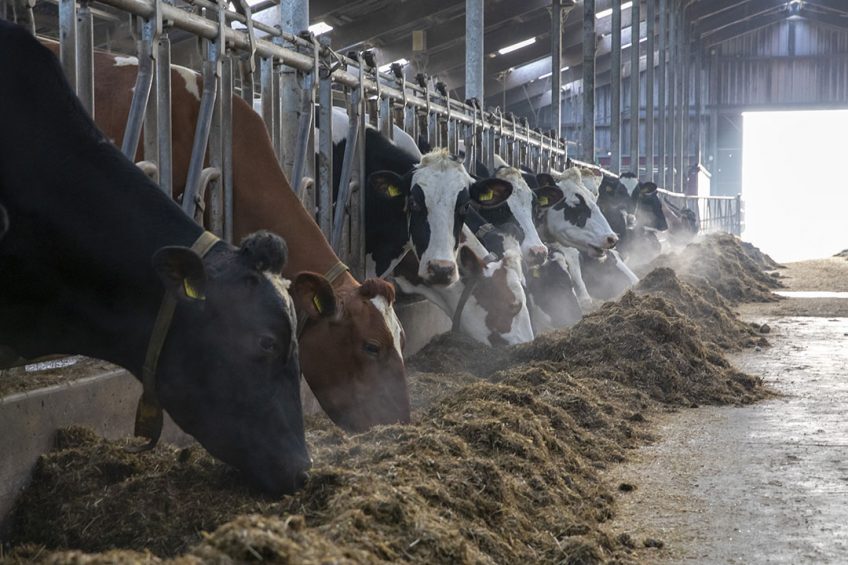More focus on cow gut health

Leaky gut syndrome receives a lot of attention. Yet, questions remain about the cause, consequences and treatment of it.
Little is known about the influence of the gut on dairy cow health. Leaky gut syndrome has received a lot of attention lately, caused in part by the lectures of American researcher Lance Baumgard, who gave presentations in multiple countries. Leaky gut can occur when the intestinal wall is damaged, for example by inflammation, stress situations or a temporary inability to eat. This causes the gut’s barrier function to be disrupted, which in turn can lead to toxins and bacteria leaking into the bloodstream through the intestine and the other way around. The balance in the intestinal wall can easily be disturbed because it needs to be able to let nutrients pass through yet stop harmful substances and bacteria from entering.
Damaged intestinal wall
Because the intestinal wall is thinner than the rumen wall, it can damage more easily. The symptoms of rumen acidosis and intestinal acidosis are difficult to discern. A cow with a leaky gut may seem completely fine on the outside. In some cases, gut slime and (surface) particles of the intestinal wall can be found in the manure. Unfortunately there are no blood or manure test available to determine leaky gut syndrome. “The gut can only be looked at during a necropsy. This is not often done in day to day practice and even then, it remains questionable whether the issues occurred because of gut problems or because of another primary cause,” says Ant Koopmans, researcher at Schothorst Feed Research.
Feeding too much resistant starch is not beneficial.”
Much remains unclear
In the Netherlands, nutritional research into leaky gut in cattle has not been conducted yet. However, the Schothorst Feed Research is preparing to look into biomarkers to determine leaky gut. “In the case of species with one stomach (pigs, poultry and people) more research has been done into the gut’s influence on overall health. For ruminants however, the rumen is seen as the most important area where disruptions could take place,” says Koopmans. This is partly because the intestine in cattle is difficult to isolate. Research is therefore complicated and expensive. “In about 5 to 10 years, we will hopefully know a lot more.”
Royal GD Animal Health, the Dutch animal health service, cannot take away these uncertainties about leaky gut yet. “In the discussion that emerged in the past year, it is said that leaky gut is an isolated syndrome that may be a central cause of many complications in dairy cattle. In GD’s opinion, no scientific evidence for this statement has been found. At this moment, GD follows the scientific developments, but does not conduct its own active research into leaky gut,” says Koopman.
Causes of leaky gut
- Transition period
- Feed restrictions
- Psychological stress
- Too much starch in the large intestine
- Too many bacteria in the small intestine
- Weaning
- Inflammation elsewhere in the animal
- Gut acidosis
- Heat stress
American research
The American researcher Lance Baumgard gave several lectures about leaky gut some time ago. He did this on the invitation of Zinpro, among others. The company produces Availa-Zn, which is zinc bound to amino acids. “This zinc compound strengthens the intestinal wall and ensures a better immune system,” says Jan van der Meer from Zinpro. Baumgard, who is a professor of animal science at Iowa State University, has no doubts, who says “heat stress and ketosis have one thing in common: leaky gut.” The consequences of leaky gut syndrome he mentions are for example production decrease, udder and claw problems.
Role of farmer and feed
According to feed suppliers, dairy farmers themselves can do much more to prevent rumen and gut problems. It is important to provide a balanced and well-mixed ration that can be eaten regularly during the day. It is important that the ‘calculated ration’ is actually fed and eaten. “Feeding too much resistant starch is not beneficial,” adds Koopmans. “Recently harvested silage maize for example contains a lot of resistant starch which can easily lead to acidosis. When the feed supply is very dry, chances are the animals pick out the concentrated parts out of the feed. By adding in some water for example, this can be prevented. Try to give the same ration every day or if you need to, implement changes in the feed very slowly. Cows are very resilient, which amazes me time and time again. However, they do need a regular and good supply of feed.”
Author:
Kristel van Veen







